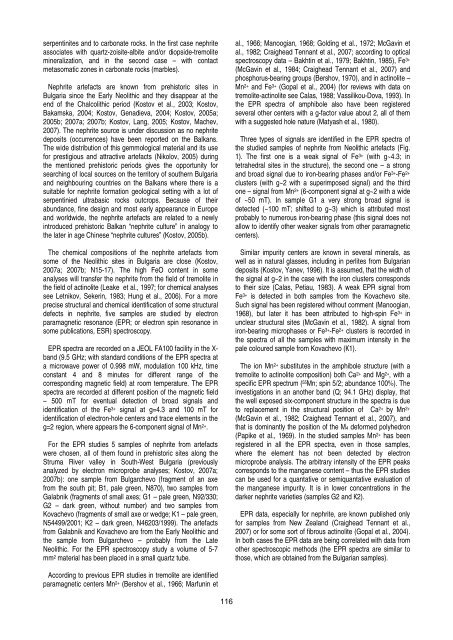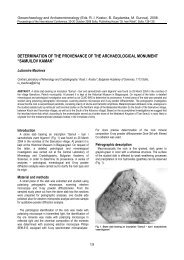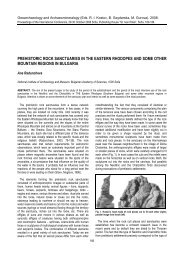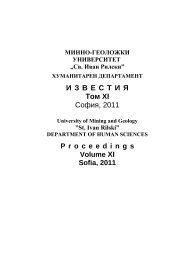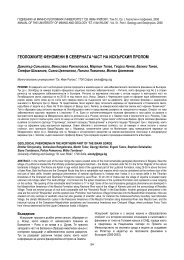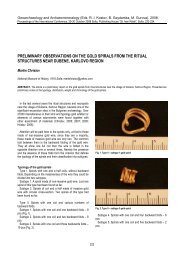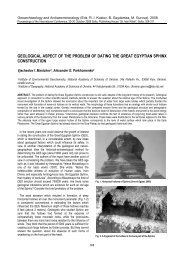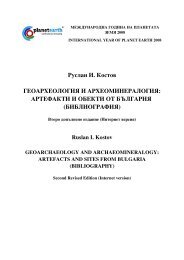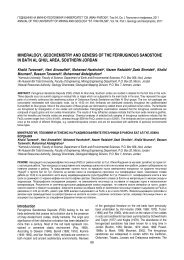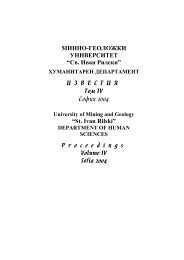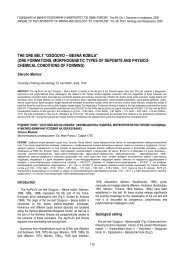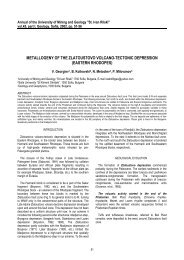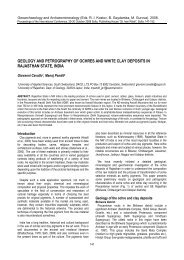electron paramagnetic resonance (epr) spectroscopy of nephrite
electron paramagnetic resonance (epr) spectroscopy of nephrite
electron paramagnetic resonance (epr) spectroscopy of nephrite
You also want an ePaper? Increase the reach of your titles
YUMPU automatically turns print PDFs into web optimized ePapers that Google loves.
serpentinites and to carbonate rocks. In the first case <strong>nephrite</strong><br />
associates with quartz-zoisite-albite and/or diopside-tremolite<br />
mineralization, and in the second case – with contact<br />
metasomatic zones in carbonate rocks (marbles).<br />
Nephrite artefacts are known from prehistoric sites in<br />
Bulgaria since the Early Neolithic and they disappear at the<br />
end <strong>of</strong> the Chalcolithic period (Kostov et al., 2003; Kostov,<br />
Bakamska, 2004; Kostov, Genadieva, 2004; Kostov, 2005;<br />
2005b; 2007a; 2007b; Kostov, Lang, 2005; Kostov, Machev,<br />
2007). The <strong>nephrite</strong> source is under discussion as no <strong>nephrite</strong><br />
deposits (occurrences) have been reported on the Balkans.<br />
The wide distribution <strong>of</strong> this gemmological material and its use<br />
for prestigious and attractive artefacts (Nikolov, 2005) during<br />
the mentioned prehistoric periods gives the opportunity for<br />
searching <strong>of</strong> local sources on the territory <strong>of</strong> southern Bulgaria<br />
and neighbouring countries on the Balkans where there is a<br />
suitable for <strong>nephrite</strong> formation geological setting with a lot <strong>of</strong><br />
serpentinied ultrabasic rocks outcrops. Because <strong>of</strong> their<br />
abundance, fine design and most early appearance in Europe<br />
and worldwide, the <strong>nephrite</strong> artefacts are related to a newly<br />
introduced prehistoric Balkan “<strong>nephrite</strong> culture” in analogy to<br />
the later in age Chinese “<strong>nephrite</strong> cultures” (Kostov, 2005b).<br />
The chemical compositions <strong>of</strong> the <strong>nephrite</strong> artefacts from<br />
some <strong>of</strong> the Neolithic sites in Bulgaria are close (Kostov,<br />
2007a; 2007b; N15-17). The high FeO content in some<br />
analyses will transfer the <strong>nephrite</strong> from the field <strong>of</strong> tremolite in<br />
the field <strong>of</strong> actinolite (Leake et al., 1997; for chemical analyses<br />
see Letnikov, Sekerin, 1983; Hung et al., 2006). For a more<br />
precise structural and chemical identification <strong>of</strong> some structural<br />
defects in <strong>nephrite</strong>, five samples are studied by <strong>electron</strong><br />
<strong>paramagnetic</strong> <strong>resonance</strong> (EPR; or <strong>electron</strong> spin <strong>resonance</strong> in<br />
some publications, ESR) <strong>spectroscopy</strong>.<br />
EPR spectra are recorded on a JEOL FA100 facility in the band<br />
(9.5 GHz; with standard conditions <strong>of</strong> the EPR spectra at<br />
a microwave power <strong>of</strong> 0.998 mW, modulation 100 kHz, time<br />
constant 4 and 8 minutes for different range <strong>of</strong> the<br />
corresponding magnetic field) at room temperature. The EPR<br />
spectra are recorded at different position <strong>of</strong> the magnetic field<br />
– 500 m for eventual detection <strong>of</strong> broad signals and<br />
identification <strong>of</strong> the Fe 3+ signal at g=4.3 and 100 mT for<br />
identification <strong>of</strong> <strong>electron</strong>-hole centers and trace elements in the<br />
g=2 region, where appears the 6-component signal <strong>of</strong> Mn 2+.<br />
For the EPR studies 5 samples <strong>of</strong> <strong>nephrite</strong> from artefacts<br />
were chosen, all <strong>of</strong> them found in prehistoric sites along the<br />
Struma River valley in South-West Bulgaria (previously<br />
analyzed by <strong>electron</strong> microprobe analyses; Kostov, 2007a;<br />
2007b): one sample from Bulgarchevo (fragment <strong>of</strong> an axe<br />
from the south pit; B1, pale green, N870), two samples from<br />
Galabnik (fragments <strong>of</strong> small axes; G1 – pale green, N92/330;<br />
G2 – dark green, without number) and two samples from<br />
Kovachevo (fragments <strong>of</strong> small axe or wedge; K1 – pale green,<br />
N54499/2001; K2 – dark green, N46203/1999). The artefacts<br />
from Galabnik and Kovachevo are from the Early Neolithic and<br />
the sample from Bulgarchevo – probably from the Late<br />
Neolithic. For the EPR <strong>spectroscopy</strong> study a volume <strong>of</strong> 5-7<br />
mm 2 material has been placed in a small quartz tube.<br />
According to previous EPR studies in tremolite are identified<br />
<strong>paramagnetic</strong> centers Mn 2+ (Bershov et al., 1966; Marfunin et<br />
116<br />
al., 1966; Manoogian, 1968; Golding t al., 1972; McGavin et<br />
al., 1982; Craighead Tennant t al., 2007; according to optical<br />
<strong>spectroscopy</strong> data – Bakhtin et al., 1979; Bakhtin, 1985), Fe 3+<br />
(McGavin et al., 1984; Craighead Tennant t al., 2007) and<br />
phosphorus-bearing groups (Bershov, 1970), and in actinolite –<br />
Mn 2+ and Fe 3+ (Gopal t al., 2004) (for reviews with data on<br />
tremolite-actinolite see Calas, 1988; Vassilikou-Dova, 1993). In<br />
the EPR spectra <strong>of</strong> amphibole also have been registered<br />
several other centers with a g-factor value about 2, all <strong>of</strong> them<br />
with a suggested hole nature (Matyash et al., 1980).<br />
Three types <strong>of</strong> signals are identified in the EPR spectra <strong>of</strong><br />
the studied samples <strong>of</strong> <strong>nephrite</strong> from Neolithic artefacts (Fig.<br />
1). The first one is a weak signal <strong>of</strong> Fe3+ (with g~4.3; in<br />
tetrahedral sites in the structure), the second one – a strong<br />
and broad signal due to iron-bearing phases and/or Fe<br />
3+-Fe 2+<br />
clusters (with g~2 with a superimposed signal) and the third<br />
one – signal from Mn 2+ (6-component signal at g~2 with a wide<br />
<strong>of</strong> ~50 mT). In sample G1 a very strong broad signal is<br />
detected (~100 mT; shifted to g~3) which is attributed most<br />
probably to numerous iron-bearing phase (this signal does not<br />
allow to identify other weaker signals from other <strong>paramagnetic</strong><br />
centers).<br />
Similar impurity centers are known in several minerals, as<br />
well as in natural glasses, including in perlites from Bulgarian<br />
deposits (Kostov, Yanev, 1996). It is assumed, that the width <strong>of</strong><br />
the signal at g~2 in the case with the iron clusters corresponds<br />
to their size (Calas, Petiau, 1983). A weak EPR signal from<br />
Fe 3+ is detected in both samples from the Kovachevo site.<br />
Such signal has been registered without comment (Manoogian,<br />
1968), but later it has been attributed to high-spin Fe 3+ in<br />
unclear structural sites (McGavin et al., 1982). A signal from<br />
iron-bearing microphases or Fe 3+-Fe 2+ clusters is recorded in<br />
the spectra <strong>of</strong> all the samples with maximum intensity in the<br />
pale coloured sample from Kovachevo (1).<br />
The ion Mn 2+ substitutes in the amphibole structure (with a<br />
tremolite to actinolite composition) both Ca 2+ and Mg 2+, with a<br />
specific EPR spectrum ( 55Mn; spin 5/2; abundance 100%). The<br />
investigations in an another band (Q; 94.1 GHz) display, that<br />
the well exposed six-component structure in the spectra is due<br />
to replacement in the structural position <strong>of</strong> Ca 2+ by n 2+<br />
(McGavin et al., 1982; Craighead Tennant t al., 2007), and<br />
that is dominantly the position <strong>of</strong> the 4 deformed polyhedron<br />
(Papike et al., 1969). In the studied samples Mn 2+ has been<br />
registered in all the EPR spectra, even in those samples,<br />
where the element has not been detected by <strong>electron</strong><br />
microprobe analysis. The arbitrary intensity <strong>of</strong> the EPR peaks<br />
corresponds to the manganese content – thus the EPR studies<br />
can be used for a quantative or semiquantative evaluation <strong>of</strong><br />
the manganese impurity. It is in lower concentrations in the<br />
darker <strong>nephrite</strong> varieties (samples G2 and 2).<br />
EPR data, especially for <strong>nephrite</strong>, are known published only<br />
for samples from New Zealand (Craighead Tennant t al.,<br />
2007) or for some sort <strong>of</strong> fibrous actinolite (Gopal et al., 2004).<br />
In both cases the EPR data are being correlated with data from<br />
other spectroscopic methods (the EPR spectra are similar to<br />
those, which are obtained from the Bulgarian samples).


